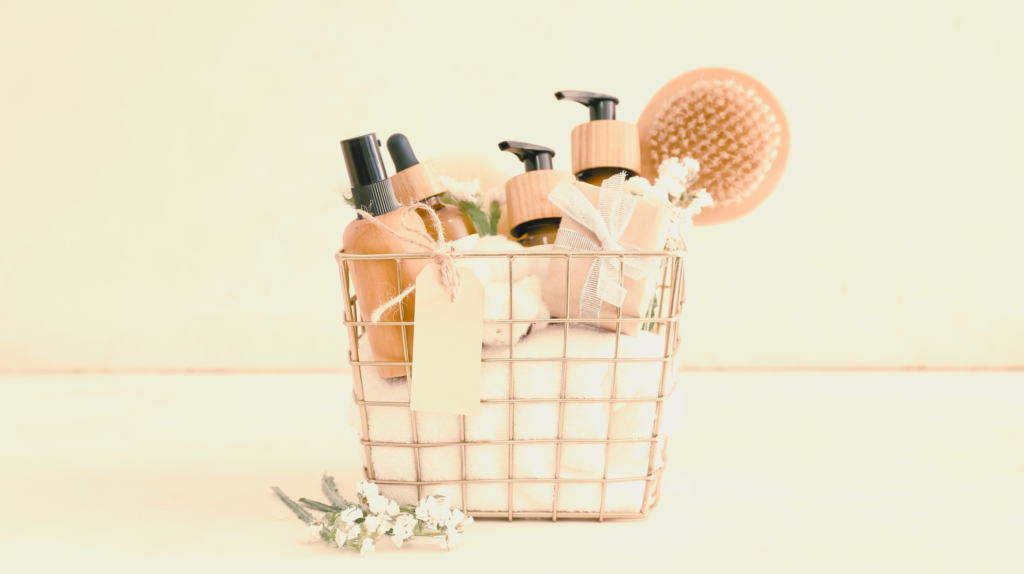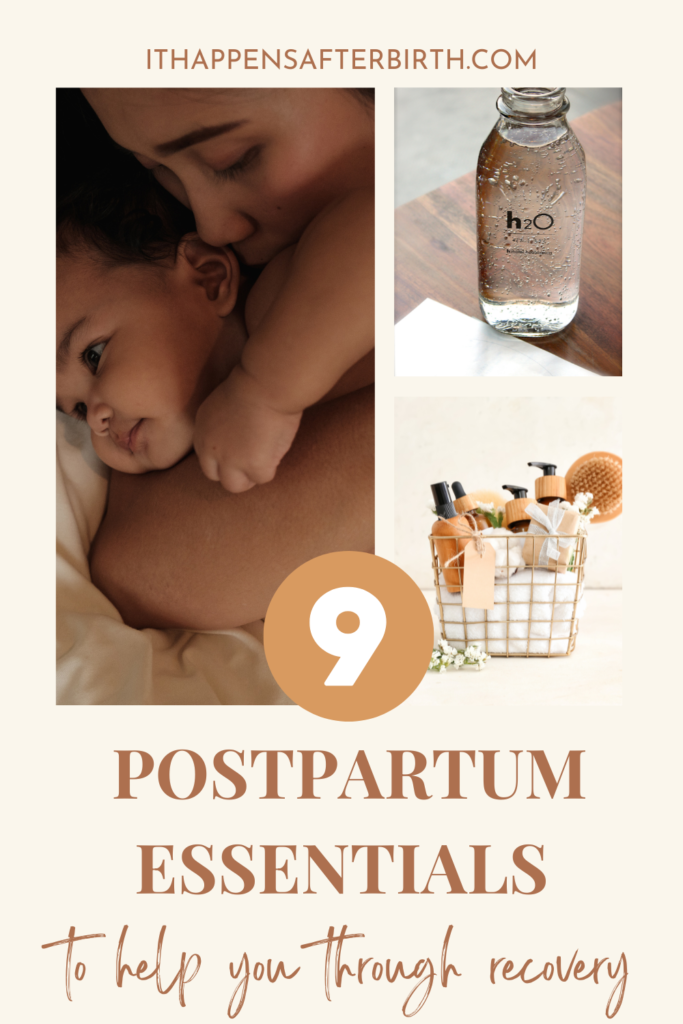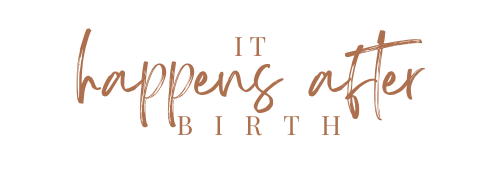
Curious what you’ll need after birth? Take a look at this list of postpartum essentials.
Having a baby comes with lots of preparation. Most of the time the focus is on birth and newborn care, and rightfully so. But what about after birth? Postpartum care for you is just as essential as care for your newborn.
Like birth, guessing what you’ll actually need during postpartum can become confusing and complicated. Fortunately, I’ve narrowed down the postpartum essentials- the items that you will want to have on hand after birth.
1. Peri bottle
The peri bottle is a must-have for anyone who’s given birth vaginally. It’s a gentle way of cleansing yourself after using the bathroom, or lessening the sting of urine while using the bathroom. You’ll want to keep using it as long as feels comfortable for you. And the best part is, you don’t even have to buy one! Any regular squeeze bottle can function as a peri bottle if you’re short on time or resources. If you’d rather buy one, there many options online (including this conveniently designed bottle from Frida Mom!)
2. Witch Hazel
Despite its intriguing name, witch hazel is an amazing plant that comes in bottled liquid form. It can help soothe everything from varicose veins to hemorrhoids (which can, unfortunately, occur postpartum) to the tears or bruises that occurred from birth. There are a few different options for using witch hazel during postpartum recovery, including mixing with water and using in your peri bottle. Another option is to mix it with pure aloe vera juice and make your own homemade padsicles (an item which will be covered below!)
3. Disposable underwear/massive pads
Nobody likes to hear about this part, but it’s true. Whether you had a vaginal birth or a c-section, you will be having massive period-like bleeding for a while known as lochia. Your uterus is cleaning out the remnants of the placenta and extra blood from pregnancy, and it’s all going to come out of you.
You’ll want to make sure you have either disposable underwear or the biggest maxi pads you can find- and sometimes both! You won’t want to leak all over your bed or piece of furniture that you’re sitting on, and being able to throw the whole underwear away makes clean up in those first few days even easier.
4. Nursing Bra
If you are planning on breastfeeding your infant, a nursing bra is one of the items I would absolutely recommend investing in. There are so many more nursing wardrobe options now then there were two decades ago, but most of them can be skipped aside from this one. If you’re nursing, you’ll be needing to take your breast out 8-12 times a day. Your breasts will also be sore and enlarged for the first few weeks as your milk is regulating. Nursing bras are designed for easy access, good support, and maximum comfort- you may even want to wear it at night too! Don’t feel bad about investing in a high-quality one, either. The price tag will be higher, but a good-quality bra is always worth it.
5. Sitz bath essentials
A sitz bath, if you haven’t already heard of it, is a shallow bath of 1-2 inches warm water. Often, it’s mixed with epsom salts or herbs to create a more soothing effect. If you’ve had a vaginal birth, a sitz bath will be essential in pain relief and recovery. Studies show that sitz baths help promote healing by increasing blood flow to the tissues, and is also a proven pain relief. A sitz bath can be made with only water, but adding epsom salts or herbs (known for their soothing effects) can help too. Want to know more about sitz baths? Check out this post.
For a sitz bath, all you actually need is a clean bathtub and water. If you don’t have a bathtub or prefer not to use it, you can buy a sitz bath container. You can also purchase the epsom salts or herbs (including in herbal tea form, if you like!) online or in most grocery/health food stores.
6. Padsicles and/or ice packs
It’s safe to say that you might be very sore, bruised, or swollen down there after giving birth. A quick way to find relief is by using cold therapy! It may not sound the most comfortable, but it actually helps tremendously. Plenty of online postpartum stores sell cold packs for your underwear, but you can also make them yourself. All you need is:
- Disposable pads
- Pure aloe vera juice
- Witch hazel
- Essential oils, if open to using them (always check with your care provider first!)
In a spray bottle, combine liquid ingredients and shake to mix well. Open the pad (do not remove from plastic backing) and spray 3-5 times with mixture. Fold the pads up and store in the freezer until needed!
7. Water Bottle
There’s nothing specifically postpartum about a water bottle, but it’s worth a spot in this list. Water is essential to life- and it can easily be considered one of our postpartum essentials for the same reasons. Keeping yourself hydrated helps with bladder regulation, flushing out toxins, and overall health and well-being (both physically and mentally). Plus if you’re breastfeeding, you’ll need to replenish the extra fluid you’re losing through breastmilk. And one of the ways you might experience that is through constant thirst!
This is where a large, quality water bottle comes in handy. Keep it filled and keep it with you!
8. Wound Care/Spray
During vaginal birth, you may have torn or gotten an episiotomy. If you had a c-section, you will have an incision. All of these can benefit from wound care.
If you’re looking for more natural options, there are some studies that show lavender essential oil is beneficial to both healing and pain relief for episiotomies. This could also apply to stitches for natural tears. (Please always check with your care provider before using any form of essential oils.)
Studies have also found honey to be beneficial in healing, for tears and for c-section incisions.
Some women prefer using witch hazel. Others will use lidocaine numbing spray such as dermoplast. Numbing spray is not beneficial for healing and isn’t recommended to be used on broken skin or open wounds, but it can help with pain management.
9. Postpartum Abdominal Support Binder
Last on the list of postpartum essentials is an abdominal binder. After birth, your uterus needs to shrink back down to normal size, your organs need to move back into place, and your back and core muscles need to learn to function in a non-pregnant state again. All of these can be helped by an abdominal support binder!
A binder can be especially helpful after having a c-section. Some women report their abdomens feeling like jelly, or feeling that their “insides are going to spill out” the first several days after a c-section. An abdominal binder can help give extra support, which makes walking and doing basic tasks easier.
Binders have the best effect when worn consistently for 6 weeks, so it is a commitment. But it’s worth having on hand for extra support during the first week or two, even if you don’t end up using it as long as it’s intended.
Binders can help with core stabilization and even help with healing.
But use cautiously too! Wearing a binder too tight can lead to hernias or pelvic organ prolapse. Wearing it too long can cause your core muscles to stop functioning the way they’re supposed to, as it is now relying on the binder to do the job.
Ultimately, whether or not to use a binder is a personal choice.
Postpartum Essentials Are Here To Help
Now that we’ve covered postpartum essentials, I do need to say that this list is not conclusive. Everyone’s experience after birth is different, and you may find yourself adding to or subtracting from the postpartum essentials listed above.
This list is simply gathered from what I’ve found to be most helpful to most women during their postpartum recovery!

